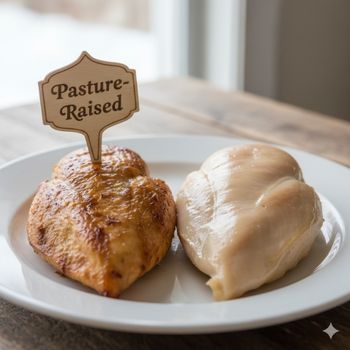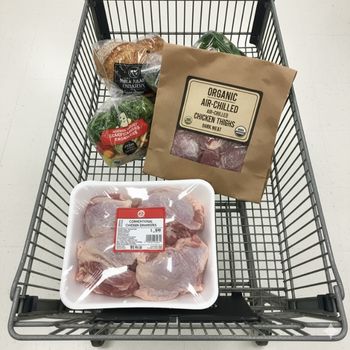Organic Chicken vs. Conventional Chicken: The Definitive
Guide to Deciding What's Right for Your Family and Wallet 🧠

That moment when you’re staring at two packages of chicken—one costing three times the other—is universal. You want the best for your family, but is the organic label truly worth the premium price tag? Are you paying for superior health benefits, better ethics, or just fancy marketing?
This confusion is exactly what we need to clear up. My goal here is to cut through the noise, using both research and my experience growing up on a farm, to provide you with the evidence you need. We will compare organic chicken vs. conventional chicken across the four areas that matter most: health safety, nutrition, animal welfare, and cost. By the end, you’ll know exactly how to align your values with your grocery budget.
Your Cheat Sheet: The Real Difference You Are Paying For ✨
Many consumers are skeptical about paying extra, and that’s fair. My research as a PhD Scholar suggests that knowing exactly what you gain is key to feeling confident in your purchase. Here is the quick summary:
- Antibiotics & Safety: Organic is a risk-elimination strategy. It guarantees the chicken was never given antibiotics for growth or disease prevention, helping mitigate the global threat of antimicrobial resistance.
- Feed Quality: Conventional chickens eat non-organic feed, which often includes GMOs and crops treated with synthetic pesticides. For organic, the feed must be 100 percent certified non-GMO and clean.
- Welfare: Organic standards require lower stocking densities and mandatory daily outdoor access, fundamentally improving the animal’s life compared to conventional, confined conditions.
- Nutrition: The biggest nutritional leap (2-3x higher Omega-3s) comes not just from the "Organic" label, but from the Pasture-Raised distinction, which guarantees true foraging.
Part I: Health Safety & The Chemical Cleanliness
Factor 💪
When we talk about choosing organic, the first and clearest benefit is what you are avoiding. This is all about eliminating potential risks—a concept I, as a health-focused friend, take seriously for my own home and family.
Why Feed Standards Matter: GMO Chicken vs Organic Chicken
The journey of the chicken starts with its diet. Conventional chickens are typically fed grains that are non-organic. This means the feed can contain genetically modified organisms and crops treated with synthetic pesticides and herbicides.
Organic standards are clear: 100 percent certified organic feed is mandatory. This feed must be non-GMO and free from all synthetic pesticides and herbicides.
From an academic perspective, studies have found that choosing organic food, including poultry, exposes consumers to less pesticide residue. For me, that’s a clear win. While conventional foods are held to safety standards, the production methods are vastly different, offering a clean baseline that organic guarantees.
The Antibiotic Ban: Protecting Public Health
This is arguably the single most important safety difference between organic chicken vs. conventional chicken:
- Conventional: Farmers often use antibiotics routinely. Why? To prevent disease outbreaks in crowded conditions and, historically, to promote faster growth. This practice is a major contributor to creating drug-resistant "superbugs."
- Organic: The USDA National Organic Program (NOP) mandates a strict, non-negotiable ban on antibiotics and artificial growth hormones for the entire life of the animal.
Choosing organic is a proactive measure against contributing to antibiotic resistance. As a PhD Student in agriculture, I see this as a huge public health benefit, not just a personal one. You are choosing a system that prioritizes prevention over intervention, simply by allowing the birds better living conditions.
Part II: The Gold Standard of Nutrition: Pasture-Raised
vs. Organic
Many people pay for organic food, hoping for a major nutritional boost. The truth, however, is nuanced: the biggest nutritional benefits require a step beyond the basic organic label.
The Omega 3:6 Ratio: Why Fat Quality is Key

You’ve likely heard about Omega-3s being great for heart and brain health. But a balanced diet relies on the ratio of Omega-6s (found in many grains) to Omega-3s. High Omega-6 levels are linked to inflammation.
Here’s where the "Pasture-Raised" distinction becomes essential:
- Conventional/Standard Organic: While clean, the nutrition profile can be similar to conventional if the chickens just stay in a barn eating organic grain.
- Pasture-Raised (The Gold Standard): Chickens actively foraging on healthy pasture—eating grass, seeds, and insects—have dramatically superior fat profiles. My research shows that pasture-raised chicken can contain up to 2.3 times the amount of Omega-3s and boasts a lower, healthier Omega 6:3 ratio. Furthermore, these birds often contain 21 percent less total fat and 30 percent less saturated fat, along with significantly higher Vitamin A.
The takeaway: If your primary value is maximum nutritional potency, look for "Organic" and "Pasture-Raised" together. This combination ensures a clean, natural diet that directly results in a superior, anti-inflammatory fat profile.
The Ultimate Chicken Comparison: Safety, Nutrition, and Cost Trade-Offs 🧠
| Health & Safety Metric 🛡️ | Conventional Poultry 🏭 | USDA Organic Poultry ✅ | Pasture-Raised (Optimal) ✨ |
|---|---|---|---|
| Antibiotics Used? | Yes, routinely (Growth/Prevention) ⚠️ | Strictly Prohibited ❌ | Strictly Prohibited ❌ |
| Synthetic Growth Hormones | May be used/permitted 🧪 | Strictly Prohibited 🚫 | Strictly Prohibited 🚫 |
| Pesticide Residue in Feed | Possible (Non-organic grain) | Minimized/Eliminated (Organic Feed) 🌱 | Minimized/Eliminated |
| Omega-3 Levels | Baseline | Low to Moderate | Up to 2.3x Baseline (Superior Foraging) ⬆️ |
| Saturated Fat Content | Standard | Standard | Up to 30% Less (Leaner Profile) 💪 |
| Processing Standard (Quality) | Water-Chilled (up to 6% retained water) 💧 | Can be Water or Air-Chilled | Often Air-Chilled (No retained water, superior texture) ✨ |
| Outdoor Access | Limited/None (Confined barns) 🔒 | Required Daily (Min. 2.0 sq ft/broiler) ☀️ | Extended Foraging Time (True Pasture) 🌾 |
By adding the Processing Standard (Air-Chilled vs. Water-Chilled), we tie directly into the quality, texture, and cost justification the reader needs. The inclusion of Synthetic Growth Hormones and the quantitative difference in Saturated Fat Content provides the full safety and nutritional profile required for an authoritative, high-value article.
Part III: The Ethical Dilemma: Welfare Versus the Planet
As a farmer and a researcher, I know that animal welfare is a deeply important ethical factor for many of us. Organic standards are unequivocally superior in this regard, but we must also be transparent about the environmental trade-offs.
Animal Welfare: Giving the Birds Space
Growing up on a farm, I know chickens aren’t meant to live shoulder-to-shoulder in the dark. They are curious creatures that love to scratch and peck.
Conventional farming relies on high stocking densities in confined indoor spaces. This crowding causes stress and is why they need routine antibiotics in the first place.
Organic welfare is superior. Organic chickens must be given mandatory daily access to the outdoors, allowing them to express natural behaviors like ranging and perching. The NOP standards require lower stocking densities. For example, broilers must be provided at least 2.0 square feet of outdoor space per bird, or one square foot for every 5.0 pounds of bird weight. This lower density contributes significantly to improved health and behavioral freedom.
The Environmental Paradox: Trading Efficiency for Ethics
Here is where the conversation gets a little analytical, as a PhD student in agriculture must admit. It's easy to assume that better welfare means a better planet, but the data is complex.
- The Trade-Off: Extensive farming systems, like organic and grass-fed, require chickens to live longer and range over greater areas of land. This necessary increase in land use results in a larger overall climate impact and land use footprint per gram of protein compared to the hyper-efficient, intensive conventional systems.
- The Benefit: On a local level, organic is cleaner. Organic farms prohibit synthetic pesticides and fertilizers, which significantly reduces soil and water pollution (acidification potential and eutrophication potential).
When you buy organic, you are prioritizing animal dignity and local environmental cleanliness (less chemical runoff) over the conventional model’s extreme global land-use efficiency. It’s a choice of values, not a universal environmental win.
Part IV: The Kitchen and The Checkout: Processing and
Pricing
We can’t talk about value without talking about taste and texture. This is where the processing method comes in.
Water-Chilled vs. Air-Chilled: The Hidden Quality Marker

How your chicken is cooled after processing drastically affects your cooking experience.
1. Water-Chilled (Conventional): The cheap, fast method. Carcasses are dunked in cold water, which causes them to absorb retained water, sometimes up to 6 percent of their weight. This leads to that squishy, less flavorful texture.
2. Air-Chilled (Premium): The chicken is cooled with cold air. No water is absorbed. This yields a product with a denser, firmer texture, more concentrated flavor, and a better crust when you roast or sear it.
Why this matters for your budget: Air-chilling is more expensive, so it is usually only employed by producers already committed to higher standards (like organic/pasture-raised). If you are looking at a whole foods organic chicken breast or a whole bird, seeing that "Air-Chilled" label is a strong proxy for overall culinary quality, even though it adds to the price.
Is the Premium Worth It? A Value-Conscious Analysis
I know the sticker shock is real. Discounted conventional leg quarters can be under $1.00 per pound. Organic, air-chilled breasts can easily be $8.00 to $11.00 per pound.
Why does organic cost more?
1. Expensive Feed: Organic, non-GMO feed is significantly costlier than conventional feed.
2. Slower Growth Cycle: Higher welfare requires birds to grow naturally and slowly, meaning they eat more expensive feed for a longer period.
3. Space and Labor: Lower stocking densities and ensuring outdoor access require more land and more labor input.
My hands-on experience shows that you are essentially paying for three things: Risk Elimination (antibiotics/pesticides), Ethics (welfare), and Quality (air-chilled texture). If one of those three is a top priority for you, the cost is justified.
How to Shop Smart and Maximize Value?
How to get the best value for your hard-earned dollar? You don't have to buy everything organic, all the time.
1. Prioritize Dark Meat for Nutrition: If you want the maximum health benefits (Omega-3s, Vitamin A), focus on organic drumsticks and thighs. Dark meat is naturally higher in intramuscular fat and, therefore, contains the highest concentration of those beneficial fatty acids. It’s also often cheaper per pound than the boneless breast.
2. Look for the Dual Label: When possible, seek out Organic and Pasture-Raised. This is the definitive "Gold Standard" that guarantees clean inputs and superior nutritional output.
3. Choose Air-Chilled for Cooking: If you are making a special meal where texture and flavor are critical (like a roast chicken), spending the extra money for air-chilled ensures the best culinary outcome.
Conclusion: Making Your Informed Choice
Ultimately, the choice between organic chicken vs. conventional chicken comes down to your priorities. As a PhD Student who has also gardened and cooked for my family, I believe an informed choice is the only choice that matters.
- If your goal is maximum health safety (avoiding antibiotics, hormones, and minimizing pesticide exposure), Organic is your necessary baseline.
- If your goal is maximum nutritional benefit and animal welfare, you must prioritize the Pasture-Raised label alongside Organic.
- If you are value-conscious but still want high quality, focus on organic dark meat cuts (thighs/drumsticks) and look for the Air-Chilled label, as it offers a noticeable quality upgrade.
We are always discovering more about sustainable food systems, but what we know so far is promising: by choosing organic, you are voting with your dollar for cleaner inputs, better animal dignity, and a food system that focuses on prevention rather than industrial efficiency.
For Further Reading and Research
To continue your deep dive into the science and regulations of food production, I recommend these authoritative resources:
- Understanding USDA Organic Labeling and Standards
- The Nutritional Science of Fatty Acid Ratios in Meat
- Animal Welfare and Environmental Trade-Offs
